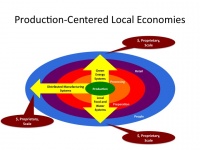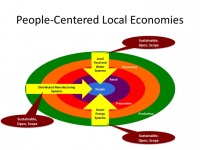Product-Centered Business Supply Chain Development vs People-Centered Business Network Ecosystem Development
Text
By Sam Rose, Paul B. Hartzog, and Richard C. Adler and informed in part by collaborations with Steve Bosserman.
Adapted from http://www.localfoodsystems.org/comparing-business-development-paradigms
Product centered business supply chain development
Product centered supply chain business development depends on:
- unlimited growth
- exclusive access to resources
- artificial scarcity around actually abundant resources
- people filling roles in a linear system
- hoarding of surplus
This way of operating focuses on what is being produced, and requires people to be largely fixed into roles to serve the linear supply chain model. People and natural systems are generally considered to be "resources" that are raw materials and labor for production and distribution, end-points consumption. Linearity in this production model leads to seeking more raw materials for more production/distribution/consumption. The organization in this system is around the assumption of unlimited growth. All actors in this system are all seeking unlimited growth at the same time. The competition around unlimited growth tends to lead to a focus of finding and capturing the largest "markets" before others find and capture it.
Markets for product-centered supply chain business development tend to look at statistics and averages of different factors of people and resources, in order to identify the largest markets.
In product centered supply chain business development, when systems reveal a "power law" distribution when ranking quantity and frequency, actors tend to ignore the "tail" and focus on on the "head" of the "power law" distribution.
It is reasonable to assume that unlimited growth, without transformation of waste into "food" for the system, cannot be sustained. It is plausible to conclude that currently struggling, and in some cases collapsing industrial systems that are focused on production/products over people are, in decline. Most of our existing efforts in economic development tend to be focused on shoring up/preventing this collapse. Resources, time, energy are directed towards activities that are still focused on product-centered development, which is a development that requires ever more resources, ever more growth. As this growth declines, people leave geographic areas and relocate to where the growth is perceived to be happening. However, the systems they leave behind are still firmly fixed in product-centered development.
This collapsing product-centered economic development activity tends to focus on creating "employment", attracting business who bring "jobs" to an area. Communities are focusing on preventing the collapse of an unsustainable system, and are ignoring what is *emerging*. What is emerging is "people centered business network ecosystem development".
People centered business network ecosystem development
"People centered" means that control of infrastructure, access, distribution, resources, and co-governance are now on the scale of the individual person. When an individual person with this empowerment reaches their individual carrying capacity to operate, they will tend to reach out to others who are operating like them, and a connection-based network will emerge. Economic development here targets individuals operating as self-employed independents who network together.
Independents, small businesses, community groups, working together, with government, higher education, and larger business are the new economic driver. The more control people have an on individual scale of infrastructure, access, distribution, resources, and governance, *and* the more connectivity there is between those people, the that more growth happens in "people centered economic development". When control of infrastructure, access, distribution, resources, and co-governance are now on the scale of the individual person, a new way of coopertive co-managing of existing resources, and surpluses of production tends to emerge. That new way of co-managing is known as "Resource Sharing":
- "The absolutely essential understanding to be absorbed here is that commons management (cooperative co-management of resources) is not primarily a technical problem but a social one and that the key ingredient in the solution is information transparency. Therefore, implementation requires a thorough grounding in both social dilemmas (Kollock) as well as technology design."
In other words: Production centered supply chain economic development can rely on technology alone to manage systems. People centered business network ecosystem development requires the engagement of all of the people in all areas of management. Technology can help, and it can primarily help by helping people to access and see the landscape of the systems they are participating in, who is connected to whom, and how? What are the real limits to resources you are using with others? What is actually scarce, what is actually abundant, and what decisions can you make together with others based on that information?
It turns out that learning, tools for problem solving, and even designs and plans and software as static objects are *not* scarce. It is very easy to copy them, especially if they exist in a digital form, and it takes very little resource to store them, and make them available to others. Individual people who are making these items tend to have very little to gain by making them scarce, as they often lack the resources needed to create that artificial scarcity around designs, knowledge, software, information. People tend to discover that there is more efficiency in sharing these creations, and working together to adapt them to immediate and long-term problems they are trying to solve (see: "Giving it away, making money" Bosserman 2008). This sharing begets more sharing when done in a way that is equitable for the people and the systems people are part of. This sharing also opens up access to individuals to control of infrastructure, freedom of access, a plausible way towards collaborating around needed distribution, and co-governance around the sharing of resources.
Actions are the focus, because all individuals now potentially have access to any "role" as it might have existed in production centered development. I can now be a designer, a marketer, a shop worker, etc Co-governed systems are "mapped" as a network ecology by looking at the resources that are shared, co-governed, or already exist as a "commons", and who the participants are. Value exchanges, and economic activity are mapped based on actions, not roles of people. Sharing what is learned, what is created, creates a way in which many others may engage, and those people now have multiple ways in which they may engage. This creates a new engine for *exponential* economic growth that is driven by people who all have access to control, and so work together to co-manage their new-found powers of control. The engine, at it's core, is "making, sharing, using". Viewing a system through the lens of actions, and having access to transparent information, gives you a view into ever-more emerging ways in which you can adapt previously-shared solutions towards emerging problems. Each adaptation of solutions to problems refines the quality of solutions available for future problem solving. This generates wealth in the ecosystem, and so is accurately described as a "wealth generating ecology".
People are in the center of this system. People with access to information co-create and share knowledge about how to convert sources into energy, how to integrate food production into waste management, how to combine physical production output with cultural production needs, how to educate their children on operating in this emerging system. These people operate as independents, networked together, and also as members of multiple existing and new types of organizations that also are "making, sharing using" in this system. This system can adapt better to change over tie, because anyone can help adapt it. This system can manage resources better, because it gives a more accurate picture of what those resources are. This system can make better use of resources because it tends to share knowledge about how to allow the outputs of one activity to become the inputs of another. This opens the door for more people to share what is abundant, create cohesive with living systems instead of destroying them, and exchange equitably around what is scarce." (http://www.localfoodsystems.org/comparing-business-development-paradigms)
Discussion and Related Graphics
-
Product centered business supply chain development as 20th cy economic paradigm (Source)
-
21st cy wealth-generating ecologies (Source)
- Product-centered economic development

Steve Bosserman writes:
"For some, a local economy is production-centered as represented in the graphic above. In this model, production is the starting point in the center. Examples include goat cheese (thanks to Abbe Turner and Lucky Penny Creamery for hosting our session!), lambs for meat, and CSAs. Output, whether food, water, energy, fuel, or housing and clothing, targets specific market niches among people in the outer ring (the arrows point outward). Output has the option of passing through the steps of processing, preparation, and retail along the way. The system is designed according to three organizing principles: money rules, keep your business to yourself (the brutal free enterprise system at work), and scale up at every opportunity to extract a competitive advantage."
- People-centered economic development
"The alternative local economy is people-centered, as depicted in the graphic above. In this instance the system starts with people as a market block in the center who, collectively, draw the output of the various systems to them based on satisfying a critical need in the most affordable, convenient, healthy, safe, and secure manner. In other words, people in a local area become the integrative agents who define the system and bring the elements together on their terms. This can be as simple as serving a plate of food from local sources, or as complex as manufactured components and assemblies in a major advanced energy installation made in local distributed manufacturing operations.

...
To continue, this concentration of people can be residents in a neighborhood or community, employees at their workplace, students, faculty, and administration at a school or university, or staff and clientele at a medical center. The point of consumption is the most important because it is here that the person in the middle chooses to purchase from a local source based on affordability, convenience, healthiness, safety, and security. Once that decision is made, the balance of retail-to-preparation-to-processing-to-production flow is organized in support of the consumer (the arrows point inward). ... The organizing principles for the system are sustainability (resilience and persistence), openness (development and collaboration), and scope (diversity and variety).
...
The people-centered approach starts with the marketing premise that people, given a viable option to choose a healthier, safer, and more secure alternative without having to compromise affordability and convenience (and taste, in the case of food), will take it. Another premise is that A system designed with attention to sustainability, openness, and scope can deliver a viable option. An institution-based local food systems such as the Cleveland Clinic - City Fresh / Cleveland Botanical Garden, or Planet Ohio - Ohio University are examples. This sets the stage for a business case presented by Steve Fortenberry and Goodness Grows to implement a Workforce Food Center concept, whereby a local food system is designed to serve several hundred employees of a large enterprise at great savings to the employer due to reduced health care costs through healthier food choices for the employees. Everyone wins. This business case will be loaded into the Ag-Bio Cluster community investment portfolio from which all can learn and benefit! "

